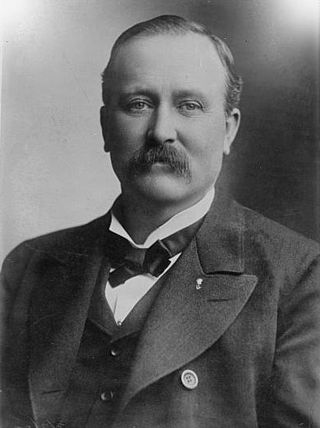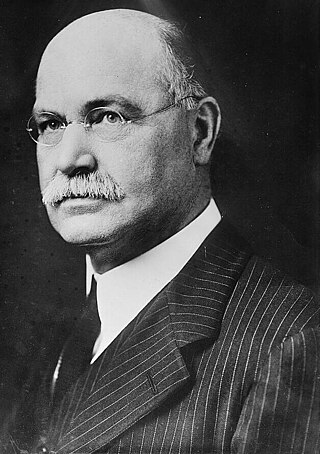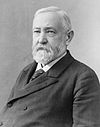
The Tariff Act of 1930, commonly known as the Smoot–Hawley Tariff or Hawley–Smoot Tariff, was a law that implemented protectionist trade policies in the United States. Sponsored by Senator Reed Smoot and Representative Willis C. Hawley, it was signed by President Herbert Hoover on June 17, 1930. The act raised US tariffs on over 20,000 imported goods.
A tariff is a tax imposed by the government of a country or by a supranational union on imports or exports of goods. Besides being a source of revenue for the government, import duties can also be a form of regulation of foreign trade and policy that taxes foreign products to encourage or safeguard domestic industry. Protective tariffs are among the most widely used instruments of protectionism, along with import quotas and export quotas and other non-tariff barriers to trade.
The Tariff of 1828 was a very high protective tariff that became law in the United States in May 1828. It was a bill designed to fail in Congress because it was seen by free trade supporters as hurting both industry and farming, but it passed anyway. The bill was vehemently denounced in the South and escalated to a threat of civil war in the Nullification Crisis of 1832–33. The tariff was replaced in 1833, and the crisis ended. It was called the "Tariff of Abominations" by its Southern detractors because of the effects it had on the Southern economy. It set a 38% tax on some imported goods and a 45% tax on certain imported raw materials.
The Walker Tariff was a set of tariff rates adopted by the United States in 1846. Enacted by the Democrats, it made substantial cuts in the high rates of the "Black Tariff" of 1842, enacted by the Whigs. It was based on a report by Secretary of the Treasury Robert J. Walker.
The Morrill Tariff was an increased import tariff in the United States that was adopted on March 2, 1861, during the administration of US President James Buchanan, a Democrat. It was the twelfth of the seventeen planks in the platform of the incoming Republican Party, which had not yet been inaugurated, and the tariff appealed to industrialists and factory workers as a way to foster rapid industrial growth.

The Revenue Act or Wilson-Gorman Tariff of 1894 slightly reduced the United States tariff rates from the numbers set in the 1890 McKinley tariff and imposed a 2% tax on income over $4,000. It is named for William L. Wilson, Representative from West Virginia, chair of the U.S. House Ways and Means Committee, and Senator Arthur P. Gorman of Maryland, both Democrats.

The Dingley Act of 1897, introduced by U.S. Representative Nelson Dingley Jr., of Maine, raised tariffs in United States to counteract the Wilson–Gorman Tariff Act of 1894, which had lowered rates. The bill came into effect under William McKinley the first year that he was in office. The McKinley administration wanted to slowly bring back the protectionism that was proposed by the Tariff of 1890.

The Fordney–McCumber Tariff of 1922 was a law that raised American tariffs on many imported goods to protect factories and farms. The US Congress displayed a pro-business attitude in passing the tariff and in promoting foreign trade by providing huge loans to Europe. That, in turn, bought more US goods. However, five years after the passage of the tariff, American trading partners had raised their own tariffs by a significant degree. France raised its tariffs on automobiles from 45% to 100%, Spain raised its tariffs on American goods by 40%, and Germany and Italy raised their tariffs on wheat. According to the American Farm Bureau, farmers lost more than $300 million annually as a result of the tariff.

Free trade is a trade policy that does not restrict imports or exports. In government, free trade is predominantly advocated by political parties that hold economically liberal positions, while economic nationalist and left-wing political parties generally support protectionism, the opposite of free trade.

Protectionism, sometimes referred to as trade protectionism, is the economic policy of restricting imports from other countries through methods such as tariffs on imported goods, import quotas, and a variety of other government regulations. Proponents argue that protectionist policies shield the producers, businesses, and workers of the import-competing sector in the country from foreign competitors and raise government revenue. Opponents argue that protectionist policies reduce trade, and adversely affect consumers in general as well as the producers and workers in export sectors, both in the country implementing protectionist policies and in the countries against which the protections are implemented.

Frank William Taussig (1859–1940) was an American economist who is credited with creating the foundations of modern trade theory.

In United States history, the Report on the Subject of Manufactures, generally referred to by its shortened title Report on Manufactures, is the third of four major reports, and magnum opus, of American Founding Father and first U.S. Treasury Secretary Alexander Hamilton. It was presented to the Congress on December 5, 1791.
The Tariff of 1842, or Black Tariff as it became known, was a protectionist tariff schedule adopted in the United States. It reversed the effects of the Compromise Tariff of 1833, which contained a provision that successively lowered the tariff rates from their level under the Tariff of 1832 over a period of ten years until the majority of dutiable goods were to be taxed at 20%.
The Tariff of 1832 was a protectionist tariff in the United States. Enacted under Andrew Jackson's presidency, it was largely written by former President John Quincy Adams, who had been elected to the House of Representatives and appointed chairman of the Committee on Manufactures. It reduced the existing tariffs to remedy the conflict created by the Tariff of 1828, but it was still deemed unsatisfactory by some in the South, especially in South Carolina. South Carolinian opposition to this tariff and its predecessor, the Tariff of Abominations, caused the Nullification crisis. As a result of this crisis, the 1832 Tariff was replaced by the Compromise Tariff of 1833.
The Tariff of 1857 was a major tax reduction in the United States that amended the Walker Tariff of 1846 by lowering rates to between 15% and 24%.
The Tariff of 1816, also known as the Dallas Tariff, is notable as the first tariff passed by Congress with an explicit function of protecting U.S. manufactured items from overseas competition. Prior to the War of 1812, tariffs had primarily served to raise revenues to operate the national government. Another unique aspect of the tariff was the strong support it received from Southern states.
Tariffs have historically served a key role in the trade policy of the United States. Their purpose was to generate revenue for the federal government and to allow for import substitution industrialization by acting as a protective barrier around infant industries. They also aimed to reduce the trade deficit and the pressure of foreign competition. Tariffs were one of the pillars of the American System that allowed the rapid development and industrialization of the United States. The United States pursued a protectionist policy from the beginning of the 19th century until the middle of the 20th century. Between 1861 and 1933, they had one of the highest average tariff rates on manufactured imports in the world. However American agricultural and industrial goods were cheaper than rival products and the tariff had an impact primarily on wool products. After 1942 the U.S. began to promote worldwide free trade, but after the 2016 presidential election has gone back to protectionism.
Protectionism in the United States is protectionist economic policy that erects tariffs and other barriers on imported goods. In the US this policy was most prevalent in the 19th century. At that time it was mainly used to protect Northern industries and was opposed by Southern states that wanted free trade to expand cotton and other agricultural exports. Protectionist measures included tariffs and quotas on imported goods, along with subsidies and other means, to restrain the free movement of imported goods, thus encouraging local industry.
Protective tariffs are tariffs that are enacted with the aim of protecting a domestic industry. They aim to make imported goods cost more than equivalent goods produced domestically, thereby causing sales of domestically produced goods to rise, supporting local industry. Tariffs are also imposed in order to raise government revenue, or to reduce an undesirable activity. Although a tariff can simultaneously protect domestic industry and earn government revenue, the goals of protection and revenue maximization suggest different tariff rates, entailing a tradeoff between the two aims.
The United States Senate Select Committee on the Tariff Regulation was a Select Committee for the U.S. Senate from February 25, 1823 until March 3, 1923. It is now a defunct congressional committee, having been consolidated into the Committee of Finance in 1923.













